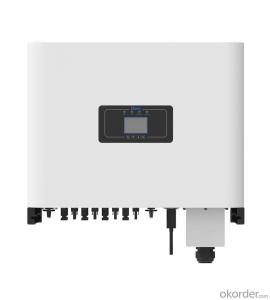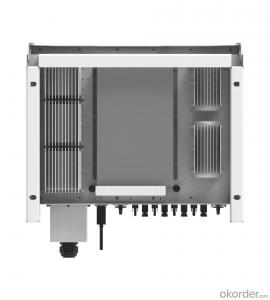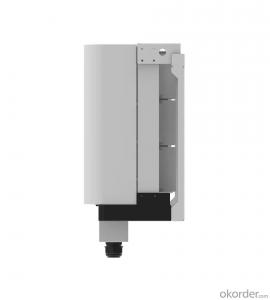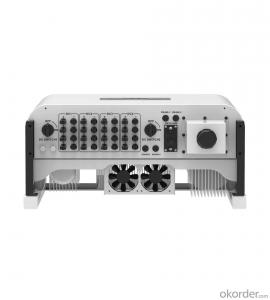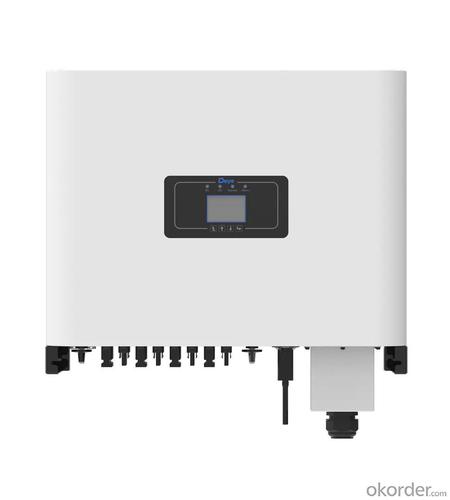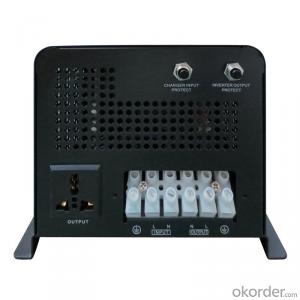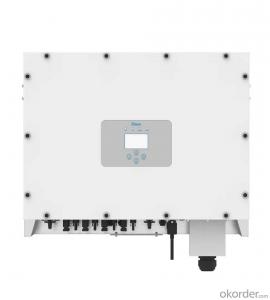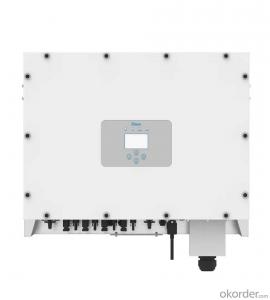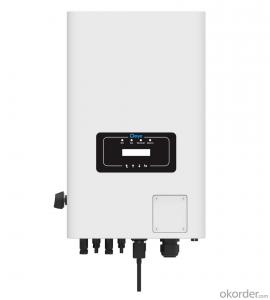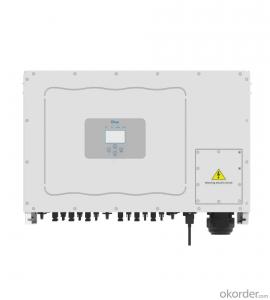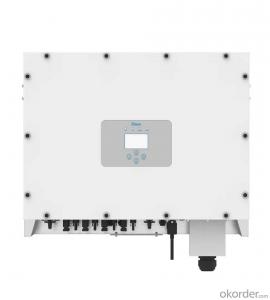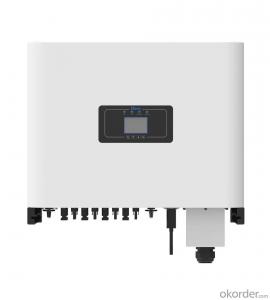Danfoss Solar Inverter - sun-30/33/35/40/50/60k-g03 | 30-60kw | Three Phase | 4 MPPT
- Loading Port:
- Ningbo
- Payment Terms:
- TT OR LC
- Min Order Qty:
- 1000 pc
- Supply Capability:
- 5000 pc/month
OKorder Service Pledge
OKorder Financial Service
You Might Also Like
Specification
| Technical Data | ||||||||
| Model | SUN-30K-G03 | SUN-33K-G03 | SUN-35K-G03 | SUN-40K-G03 | SUN-50K-G03 | SUN-60K-G03 | ||
| Input Side | ||||||||
| Max. DC Input Power (kW) | 39 | 42.9 | 45.5 | 52 | 65 | 78 | ||
| Max. DC Input Voltage (V) | 1000 | |||||||
| Start-up DC Input Voltage (V) | 250 | |||||||
| MPPT Operating Range (V) | 200~850 | |||||||
| Max. DC Input Current (A) | 40+40 | 40+40+40 | 40+40+40+40 | |||||
| Max. Short Circuit Current (A) | 60+60 | 60+60+60 | 60+60+60+60 | |||||
| Number of MPPT / Strings per MPPT | 2/3 | 3/3 | 4/3 | |||||
| Output Side | ||||||||
| Rated Output Power (kW) | 30 | 33 | 35 | 40 | 50 | 60 | ||
| Max. Active Power (kW) | 33 | 36.3 | 38.5 | 44 | 55 | 66 | ||
| Nominal Output Voltage / Range (V) | 3L/N/PE 380V/0.85Un-1.1Un, 400V/0.85Un-1.1Un | |||||||
| Rated Grid Frequency (Hz) | 50 / 60 (Optional) | |||||||
| Operating Phase | Three phase | |||||||
| Rated AC Grid Output Current (A) | 43.5 | 47.8 | 50.7 | 58 | 72.5 | 87 | ||
| Max. AC Output Current (A) | 47.9 | 52.6 | 55.8 | 63.8 | 79.7 | 95.7 | ||
| Output Power Factor | 0.8 leading to 0.8 lagging | |||||||
| Grid Current THD | <3% | |||||||
| DC Injection Current (mA) | <0.5% | |||||||
| Grid Frequency Range | 47~52 or 57~62 (Optional) | |||||||
| Efficiency | ||||||||
| Max. Efficiency | 98.7% | |||||||
| Euro Efficiency | 98% | |||||||
| MPPT Efficiency | >99% | |||||||
| Protection | ||||||||
| DC Reverse-Polarity Protection | Yes | |||||||
| AC Short Circuit Protection | Yes | |||||||
| AC Output Overcurrent Protection | Yes | |||||||
| Output Overvoltage Protection | Yes | |||||||
| Insulation Resistance Protection | Yes | |||||||
| Ground Fault Monitoring | Yes | |||||||
| Anti-islanding Protection | Yes | |||||||
| Temperature Protection | Yes | |||||||
| Integrated DC Switch | Yes | |||||||
| Remote software upload | Yes | |||||||
| Remote change of operating parameters | Yes | |||||||
| Surge protection | DC Type II / AC Type II | |||||||
| General Data | ||||||||
| Size (mm) | 647.5W×537H×303.5D | |||||||
| Weight (kg) | 44.5 | |||||||
| Topology | Transformerless | |||||||
| Internal Consumption | <1W (Night) | |||||||
| Running Temperature | -25~65℃, >45℃ derating | |||||||
| Ingress Protection | IP65 | |||||||
| Noise Emission (Typical) | <45 dB | |||||||
| Cooling Concept | Smart cooling | |||||||
| Max. Operating Altitude Without Derating | 2000m | |||||||
| Warranty | 5 years | |||||||
| Grid Connection Standard | CEI 0-21, VDE-AR-N 4105, NRS 097, IEC 62116, IEC 61727, G99, G98, VDE 0126-1-1, RD 1699, C10-11 | |||||||
| Operating Surroundings Humidity | 0-100% | |||||||
| Safety EMC / Standard | IEC/EN 61000-6-1/2/3/4, IEC/EN 62109-1, IEC/EN 62109-2 | |||||||
| Features | ||||||||
| DC Connection | MC-4 mateable | |||||||
| AC Connection | IP65 rated plug | |||||||
| Display | LCD 240×160 | |||||||
| Interface | RS485/RS232/Wifi/LAN | |||||||
This series grid-tie inverter is preferred choice for commercial PV system. With the free-standing design, it greatly reduces installation time and costs. With a Max. 4 MPPTs design and Max. capacity of 50 kW, it is scalable up to the megawatt range.
· 4 MPP tracker, Max. efficiency up to 98.7%
· Zero export application, VSG application
· String intelligent monitoring (optional)
· Wide output voltage range
· Type II DC/AC SPD
· Anti-PID function (Optional)
- Q: Can a solar inverter be used with a solar-powered agriculture system?
- Yes, a solar inverter can be used with a solar-powered agriculture system. A solar inverter is an essential component that converts the direct current (DC) electricity generated by solar panels into alternating current (AC) electricity, which is compatible with most electrical appliances and equipment. In the context of a solar-powered agriculture system, a solar inverter would be necessary to convert the electricity produced by the solar panels into the appropriate form for powering agricultural machinery, irrigation systems, or any other electrical needs on the farm.
- Q: Can a solar inverter convert DC power to AC power during a power outage?
- No, a solar inverter cannot convert DC power to AC power during a power outage. During a power outage, the solar inverter relies on the grid to function, and without grid power, it cannot convert DC power from the solar panels into usable AC power.
- Q: How does the efficiency of a solar inverter affect the overall system performance?
- The efficiency of a solar inverter plays a crucial role in the overall system performance. A higher efficiency inverter converts a greater percentage of the solar energy into usable electricity, resulting in increased energy production. This means that a more efficient inverter allows the system to generate more power, maximizing the overall performance and output of the solar system. Additionally, a higher efficiency inverter reduces energy losses, which can lead to improved system reliability and cost-effectiveness. Therefore, the efficiency of a solar inverter directly impacts the overall performance and effectiveness of the entire solar energy system.
- Q: Can a solar inverter work without batteries?
- Yes, a solar inverter can work without batteries. In a grid-tied solar system, the solar inverter converts the DC power from the solar panels into AC power that can be used in the household or fed back into the grid. Batteries are not necessary as the system relies on the grid for power supply during periods of low or no sunlight.
- Q: Can a solar inverter be used in three-phase systems?
- Yes, a solar inverter can be used in three-phase systems. In fact, there are specific three-phase solar inverters designed to convert the DC power generated by solar panels into AC power for utilization in three-phase electrical systems. These inverters are capable of efficiently managing the power flow and ensuring balanced distribution across all three phases.
- Q: What is the maximum efficiency at partial load for a solar inverter?
- The maximum efficiency at partial load for a solar inverter refers to the highest level of efficiency that can be achieved when the inverter is operating at less than its full capacity. This efficiency is typically lower than the maximum efficiency at full load, as the inverter may not be able to convert the same amount of energy with the same level of efficiency when it is not running at its maximum capacity.
- Q: Can a solar inverter be used in a hybrid solar system?
- Yes, a solar inverter can be used in a hybrid solar system. A hybrid solar system combines solar power with other sources of energy, such as batteries or a backup generator. The solar inverter is responsible for converting the DC electricity generated by the solar panels into AC electricity that can be used to power appliances and other electrical devices. In a hybrid system, the solar inverter works in conjunction with other components, such as a battery inverter or a grid tie inverter, to manage the flow of electricity between the solar panels, batteries, and the electrical grid.
- Q: How does a solar inverter impact the overall system reliability?
- A solar inverter plays a crucial role in ensuring the overall system reliability of a solar power system. It converts the direct current (DC) generated by solar panels into alternating current (AC) that is suitable for use in homes or businesses. By efficiently converting the energy and maintaining optimal voltage and frequency levels, the inverter ensures that the system operates reliably and consistently. It also provides various protective functions, such as monitoring and controlling the system's performance, detecting faults or abnormalities, and shutting down the system in case of emergencies. Therefore, a well-functioning solar inverter significantly impacts the overall system reliability by maximizing energy production, preventing damage, and ensuring smooth operation.
- Q: How does a solar inverter handle shade on solar panels?
- A solar inverter handles shade on solar panels by employing a technology called Maximum Power Point Tracking (MPPT). MPPT allows the inverter to constantly monitor the output of each individual solar panel and adjust the voltage and current to maximize the power output. When shade is present on one or more panels, the inverter can dynamically optimize the power generation by bypassing the shaded panels or reducing their impact on the overall system performance.
- Q: What is the maximum power capacity of a solar inverter?
- The maximum power capacity of a solar inverter can vary depending on its specific model and design. However, typical residential solar inverters have a power capacity range of 1-10 kilowatts (kW), while commercial and industrial inverters can range from 10 kW to several megawatts (MW).
Send your message to us
Danfoss Solar Inverter - sun-30/33/35/40/50/60k-g03 | 30-60kw | Three Phase | 4 MPPT
- Loading Port:
- Ningbo
- Payment Terms:
- TT OR LC
- Min Order Qty:
- 1000 pc
- Supply Capability:
- 5000 pc/month
OKorder Service Pledge
OKorder Financial Service
Similar products
Hot products
Hot Searches
Related keywords
